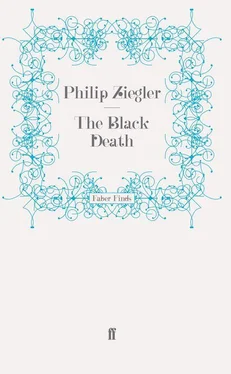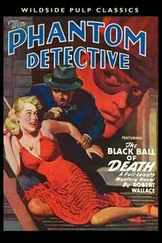But he might at least have hoped that what he lost in awfulness he would regain in the sympathies of his flock. The priests, after all, suffered and died at the side of the laity; were always, indeed, among the most likely victims. Yet the slender evidence that exists shows that they lost in popularity as a result of the plague. They were deemed not to have risen to the level of their responsibilities, to have run away in fear or in search of gain, to have put their own skins first and the souls of their parishioners a bad second. It was not only captious critics like Langland or Chaucer who so accused them but their own kind. It was the Bishop of Bath and Wells who taxed them with lack of devotion to their duty; {493} a monk who wrote: ‘In this plague many chaplains and hired parish priests would not serve without excessive pay’; {494} the chronicler of the Archbishops who complained that: ‘…parishes remained altogether unserved and beneficed parsons had turned away from the care of their benefices for fear of death’. {495} Such criticism must have reflected a general view.
One of the most perplexing features of the Black Death is the reconciliation of this criticism with the outstandingly high mortality among the priests. We have already considered the factors which contributed to this high death rate. There is much which remains uncertain. But what seems clear beyond contradiction is that, if the parish priest had chosen to devote his superior wealth and the privileges conferred by his status solely to preserving his own person, he would have stood a better chance than his parishioners of survival. The fact that he suffered more proves that he cannot altogether have shirked his duty. The picture which one forms to explain this seeming ingratitude on the part of the people towards their priests is that of a clergy doing its daily work but with reluctance and some timidity; thereby incurring the worst of the danger but forfeiting the respect which it should have earned. Add to this a few notorious examples of priests deserting their flocks and of conspicuous courage on the part of certain wandering friars, and some idea can be formed of why the established Church emerged from the Black Death with such diminished credit. The contempt of contemporaries may not have been justified but it was still to cost the Church dear over the next decades.
There is little doubt that those who wished to criticize the Church found plentiful grounds on which to do so during the next few years. On the whole, in plague as in war, those who take most care of themselves live on while those who expose themselves perish. The best of the clergy died, the worst survived. Obviously this is an over-simplification; many good men were lucky as well as less noble who were unfortunate. But the abrupt disappearance of nearly half the clergy, including a disproportionately great number of the brave and diligent, inevitably put a heavy strain on the machinery of the Church and reduced its capacity to deal effectively with movements of protest or revolt.
It does not seem that the new recruits who took the place of the dead were spiritually or, still more, educationally of the calibre of their predecessors. During and immediately after the plague the usual rules governing the ordination of priests were virtually abandoned. Many men who found themselves widowed took holy orders when already middle aged. In the diocese of Bath and Wells a priest was admitted to holy orders even though his wife was still alive and had not entered a cloister on the somewhat shaky grounds that ‘she was an old woman and could remain in the world without giving rise to any suspicions’. {496} The Bishop of Norwich obtained a dispensation to allow sixty clerks aged twenty-one or less to hold rectories on the grounds, more or less categorically stated, that they would be better than nothing. In Winchester, in 1349 and 1350, twenty-seven new incumbents became sub-deacons, deacons and priests in successive ordinations and thus arrived virtually unfledged in their new offices. {497} The Archbishop of York was authorized to hold emergency ordinations in his diocese. {498}
There is, of course, no reason to assume that a priest will be any the worse for having been married and taken to his new vocation late in life. Knighton it is true, referred to such recruits disparagingly: ‘…a very great multitude of men whose wives had died of the pestilence flocked to Holy Orders of whom many were illiterate and no better than laics except in so far as they could read though not understand’; {499} but Knighton, as a Canon Regular, had anyway little use for the secular priesthood. Nor did the fact that some of the new priests were unusually young when ordained mean that they would lack a sense of vocation or fail to become as good as their predecessors when they had gained experience. But, in the unseemly rush to fill the gaps, many unsuitable candidates must have been appointed and many novices thrust unprepared into positions of responsibility. Certainly in the first few years after the plague, when society was slowly pulling itself together, the Church must have been singularly ill-equipped to give a lead.
The ill wind of the plague blew some good even to the clergy. Coulton has calculated that, before the Black Death, the majority of livings in lay presentation were given to men not yet in priests’ Orders, often not even in Holy Orders at all. {500} Analysing the figures for four dioceses over a long period before 1348 he found that 73.8 per cent of the parishes were served by ‘non-priests’ unable to celebrate Mass, marry their parishioners or administer last rites. Most of these amateur rectors appointed professional curates to do their work but, though the souls of the parishioners might not be imperilled, the situation whereby prosperous absentees appointed qualified priests for the smallest possible wage to do the work which they were incompetent or unwilling to do themselves was not a happy one for Church or laity. During the Black Death the situation altered. The great majority of institutions went to ordained priests. The change survived the plague and an analysis of the period after the Black Death showed that the percentage of active priests in charge of benefices had more than doubled to 78 percent.
But among these novice priests and the survivors of the plague there was noticeable a new acquisitiveness; a determination to share in the wealth which fell free for the taking after the Black Death. Such a determination was understandable. Many of their demands were anyway perfectly justified; the economic difficulties of certain parish priests have already been mentioned {501} and it was often literally impossible for the parson to live on what the plague had left him of his income. But insistence upon his financial due is rarely becoming to a minister of the Church and sometimes they were greedy and excessive in their exactions. ‘A man could scarcely get a chaplain to undertake any church for less than £ 10 or ten marks,’ grumbled Knighton. ‘And whereas, while there had been plenty of priests before the plague and a man might have had a chaplain for five or six marks or for two marks and his daily bread, at this time there was scarce anyone who would accept a vicarage at £ 20 or twenty marks.’ {502} Archbishop Islip had no doubt that ‘the unbridled cupidity of the human race’ was at work among the priesthood. ‘…the priests who still survive, not considering that they are preserved by the Divine will from the dangers of the late pestilence, not for their own sakes, but to perform the Ministry committed to them for the people of God and the public utility’, were neglecting their duties and seeking better paid conditions. So bad had things got that, unless the priests at once mended their ways: ‘many, and indeed most of the churches, prebends and chapels of our and your diocese, and indeed of our whole Province, will remain absolutely without priests’. {503}
Читать дальше












